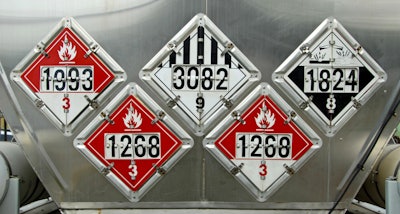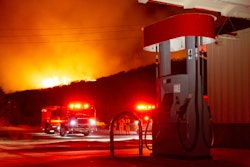
During a five-day enforcement blitz in August, officials in the U.S., Canada, and Mexico inspected more than 9,200 commercial motor vehicles carrying dangerous goods or hazardous materials and identified 683 violations serious enough to receive out-of-service orders.
A total of 9,259 inspections were part of the Commercial Vehicle Safety Alliance’s Transportation of Dangerous Goods/Hazardous Materials Road Blitz on Aug. 12-16.
According to a statement from the CVSA 15,197 packages were inspected. Of them, 8,594 were non-bulk packages/small means of containment and 6,603 were bulk packages/large means of containment (5,730 cargo tank and 873 other bulk). Inspectors found:
- 66 violations for package integrity (leaking), all of which received out-of-service orders
- 204 violations for loading and securement, all of which received out-of-service orders
- 181 other packaging violations resulting in 50 out-of-service conditions
- 432 total placarding violations, of which 102 were out-of-service conditions.
- 1,156 shipping paper violations, of which 226 were out-of-service conditions
- 171 markings violations, 3of which 5 were out-of-service conditions.
“Every day, hazardous materials are shipped throughout North America,” said CVSA President Sgt. John Samis with the Delaware State Police. “Such materials are often necessary for people’s way of life; however, these materials can also be dangerous and without proper care, rules and regulations, there is the potential to endanger human life and damage the environment.”
A statement from CVSA enumerated which dangerous goods and hazardous materials were inspected. They included:
- Class 1 explosives, such as ammunition, fireworks, flares, etc., were inspected 262 times.
- Class 2 gases were inspected 2,108 times. Class 2 gases are categorized as flammable, non-flammable/non-poisonous and poisonous.
- Class 3 flammable liquids were inspected 5,446 times. Examples of flammable liquids are acetone, adhesives, paints, gasoline, ethanol, methanol, some pesticides, etc.
- Class 4 materials were inspected 276 times. Class 4 materials are flammable solids, substances liable to spontaneously combust and substances that, on contact with water, emit flammable gases. Examples of Class 4 materials are white phosphorus and sodium.
- Class 5 oxidizing agents and organic peroxides were inspected 339 times. Class 5 materials include chemicals, such as hydrogen peroxide, potassium permanganate, sodium nitrite, ammonium nitrate fertilizers and oxygen generators.
- Class 6 toxic and infectious substances were inspected 200 times. This means any material, other than a gas, that is so toxic to humans that it presents a health hazard during transportation. Cyanide, biological samples, clinical wastes and some pesticides are examples of Class 6 hazards.
- Class 7 radioactive materials, such as cobalt and cesium, were inspected 87 times.
- Class 8 materials were inspected 1,728 times. Class 8 corrosive substances, such as sulfuric acid and sodium hydroxide, are liquid or solid corrosive materials that cause full thickness destruction of human skin at the site of contact within a specified time.
- Class 9 miscellaneous HM/DG and articles were inspected 667 times. Acetaldehyde ammonia, asbestos, elevated temperature materials and benzaldehyde are Class 9 materials.
Since 2012, Canada has held this annual week-long national enforcement blitz. This was the first time the U.S. and Mexico joined.







